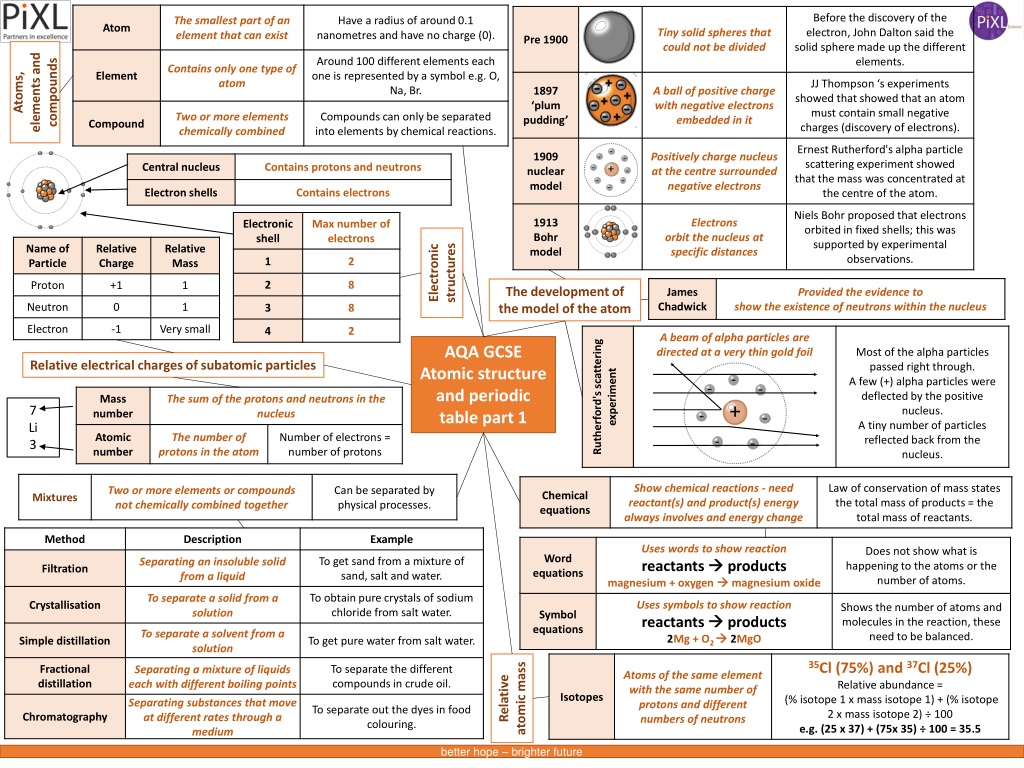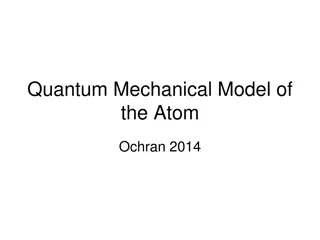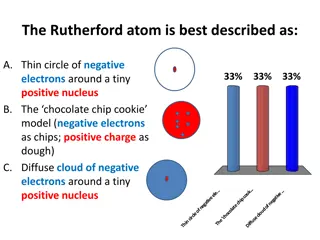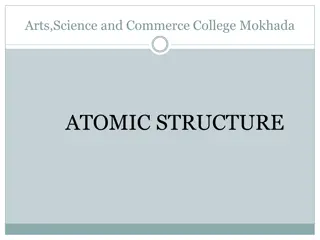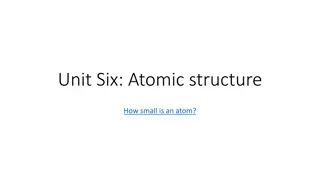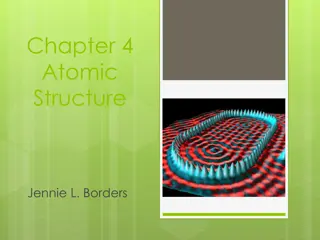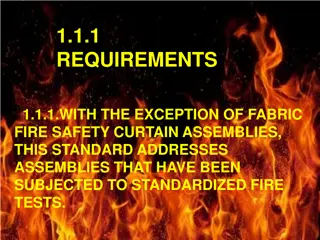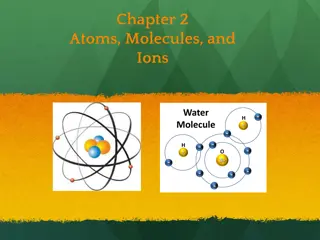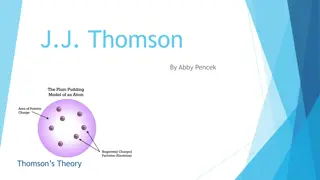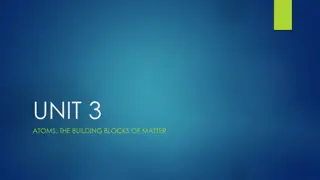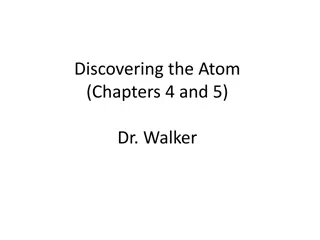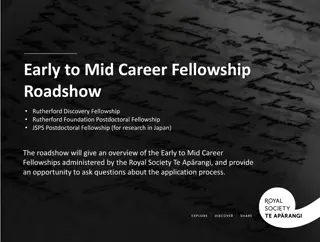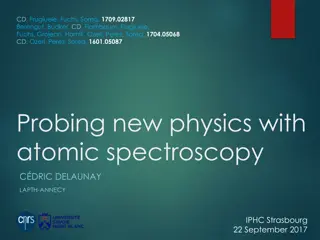Development of the Atomic Model: From Dalton to Rutherford
Before the discovery of the electron, John Dalton proposed the solid sphere model for elements, while JJ Thomson's experiments led to the discovery of electrons. Ernest Rutherford's alpha particle scattering experiment revealed the concentrated mass at the nucleus, which formed the basis of the nuclear model. Niels Bohr further proposed fixed electron orbits, and James Chadwick confirmed the existence of neutrons. The atomic structure evolved through these key discoveries, shaping our understanding of the atom.
Download Presentation

Please find below an Image/Link to download the presentation.
The content on the website is provided AS IS for your information and personal use only. It may not be sold, licensed, or shared on other websites without obtaining consent from the author. Download presentation by click this link. If you encounter any issues during the download, it is possible that the publisher has removed the file from their server.
E N D
Presentation Transcript
Before the discovery of the electron, John Dalton said the solid sphere made up the different elements. The smallest part of an element that can exist Have a radius of around 0.1 nanometres and have no charge (0). Atom Tiny solid spheres that could not be divided Pre 1900 elements and Around 100 different elements each one is represented by a symbol e.g. O, Na, Br. compounds Contains only one type of atom Atoms, Element JJ Thompson s experiments showed that showed that an atom must contain small negative charges (discovery of electrons). 1897 plum pudding A ball of positive charge with negative electrons embedded in it Two or more elements chemically combined Compounds can only be separated into elements by chemical reactions. Compound Ernest Rutherford's alpha particle scattering experiment showed that the mass was concentrated at the centre of the atom. - 1909 nuclear model Positively charge nucleus at the centre surrounded negative electrons - - Central nucleus Contains protons and neutrons + - - - - - Electron shells Contains electrons Niels Bohr proposed that electrons orbited in fixed shells; this was supported by experimental observations. 1913 Bohr model Electrons Electronic shell Max number of electrons orbit the nucleus at specific distances Electronic structures Name of Particle Relative Charge Relative Mass 1 2 2 8 Proton +1 1 The development of the model of the atom James Chadwick Provided the evidence to show the existence of neutrons within the nucleus Neutron 0 1 3 8 Electron -1 Very small 4 2 A beam of alpha particles are directed at a very thin gold foil Rutherford's scattering AQA GCSE Atomic structure and periodic table part 1 Most of the alpha particles passed right through. A few (+) alpha particles were deflected by the positive nucleus. A tiny number of particles reflected back from the nucleus. Relative electrical charges of subatomic particles experiment - - - Mass number The sum of the protons and neutrons in the nucleus + 7 Li 3 - - Atomic number The number of protons in the atom Number of electrons = number of protons - - Show chemical reactions - need reactant(s) and product(s) energy always involves and energy change Law of conservation of mass states the total mass of products = the total mass of reactants. Two or more elements or compounds not chemically combined together Can be separated by physical processes. Chemical equations Mixtures Method Description Example Uses words to show reaction reactants products magnesium + oxygen Does not show what is happening to the atoms or the number of atoms. Word equations To get sand from a mixture of sand, salt and water. Separating an insoluble solid from a liquid Filtration magnesium oxide To obtain pure crystals of sodium chloride from salt water. To separate a solid from a solution Uses symbols to show reaction reactants products 2Mg + O2 Crystallisation Shows the number of atoms and molecules in the reaction, these need to be balanced. Symbol equations To separate a solvent from a solution 2MgO Simple distillation To get pure water from salt water. 35Cl (75%) and 37Cl (25%) Relative abundance = (% isotope 1 x mass isotope 1) + (% isotope 2 x mass isotope 2) 100 e.g. (25 x 37) + (75x 35) 100 = 35.5 atomic mass Fractional distillation To separate the different compounds in crude oil. Separating a mixture of liquids each with different boiling points Atoms of the same element with the same number of protons and different numbers of neutrons Relative Isotopes Separating substances that move at different rates through a medium To separate out the dyes in food colouring. Chromatography better hope brighter future
Before the discovery of the electron, John Dalton said the solid sphere made up the different elements. The smallest part of an element that can exist Have a radius of around 0.1 nanometres and have no charge (0). Tiny solid spheres that could not be divided elements and Around 100 different elements each one is represented by a symbol e.g. O, Na, Br. compounds Contains only one type of atom Atoms, JJ Thompson s experiments showed that showed that an atom must contain small negative charges (discovery of electrons). A ball of positive charge with negative electrons embedded in it Two or more elements chemically combined Compounds can only be separated into elements by chemical reactions. Ernest Rutherford's alpha particle scattering experiment showed that the mass was concentrated at the centre of the atom. - Positively charge nucleus at the centre surrounded negative electrons - - Contains protons and neutrons + - - - - - Contains electrons Niels Bohr proposed that electrons orbited in fixed shells; this was supported by experimental observations. Electrons Electronic shell Max number of electrons orbit the nucleus at specific distances Electronic structures Name of Particle Relative Charge Relative Mass 1 2 +1 1 The development of the model of the atom Provided the evidence to show the existence of neutrons within the nucleus 0 1 3 -1 Very small 4 A beam of alpha particles are directed at a very thin gold foil AQA GCSE Atomic structure and periodic table part 1 Most of the alpha particles passed right through. A few (+) alpha particles were deflected by the positive nucleus. A tiny number of particles reflected back from the nucleus. Relative electrical charges of subatomic particles - - - The sum of the protons and neutrons in the nucleus + 7 Li 3 - - The number of protons in the atom Number of electrons = number of protons - - Show chemical reactions - need reactant(s) and product(s) energy always involves and energy change Law of conservation of mass states the total mass of products = the total mass of reactants. Two or more elements or compounds not chemically combined together Can be separated by physical processes. Method Description Example Uses words to show reaction reactants products magnesium + oxygen Does not show what is happening to the atoms or the number of atoms. To get sand from a mixture of sand, salt and water. Separating an insoluble solid from a liquid magnesium oxide To obtain pure crystals of sodium chloride from salt water. To separate a solid from a solution Uses symbols to show reaction reactants products 2Mg + O2 Shows the number of atoms and molecules in the reaction, these need to be balanced. To separate a solvent from a solution 2MgO To get pure water from salt water. 35Cl (75%) and 37Cl (25%) Relative abundance = (% isotope 1 x mass isotope 1) + (% isotope 2 x mass isotope 2) 100 e.g. (25 x 37) + (75x 35) 100 = 35.5 atomic mass To separate the different compounds in crude oil. Separating a mixture of liquids each with different boiling points Atoms of the same element with the same number of protons and different numbers of neutrons Relative Separating substances that move at different rates through a medium To separate out the dyes in food colouring. better hope brighter future
Before the discovery of the electron, John Dalton said the solid sphere made up the different elements. Have a radius of around 0.1 nanometres and have no charge (0). elements and Around 100 different elements each one is represented by a symbol e.g. O, Na, Br. compounds Atoms, JJ Thompson s experiments showed that showed that an atom must contain small negative charges (discovery of electrons). Compounds can only be separated into elements by chemical reactions. Ernest Rutherford's alpha particle scattering experiment showed that the mass was concentrated at the centre of the atom. - - - Contains protons and neutrons + - - - - - Contains electrons Niels Bohr proposed that electrons orbited in fixed shells; this was supported by experimental observations. Electronic shell Max number of electrons Electronic structures Name of Particle Relative Charge Relative Mass 1 2 +1 1 The development of the model of the atom Provided the evidence to show the existence of neutrons within the nucleus 0 1 3 -1 Very small 4 AQA GCSE Atomic structure and periodic table part 1 Most of the alpha particles passed right through. A few (+) alpha particles were deflected by the positive nucleus. A tiny number of particles reflected back from the nucleus. Relative electrical charges of subatomic particles - - - + 7 Li 3 - - The number of protons in the atom Number of electrons = number of protons - - Law of conservation of mass states the total mass of products = the total mass of reactants. Two or more elements or compounds not chemically combined together Can be separated by physical processes. Method Description Example Does not show what is happening to the atoms or the number of atoms. To get sand from a mixture of sand, salt and water. To obtain pure crystals of sodium chloride from salt water. Shows the number of atoms and molecules in the reaction, these need to be balanced. To get pure water from salt water. 35Cl (75%) and 37Cl (25%) Relative abundance = (% isotope 1 x mass isotope 1) + (% isotope 2 x mass isotope 2) 100 e.g. (25 x 37) + (75x 35) 100 = 35.5 atomic mass To separate the different compounds in crude oil. Relative To separate out the dyes in food colouring. better hope brighter future
elements and compounds Atoms, - - - + - - - - - Electronic shell Max number of electrons Electronic structures Name of Particle Relative Charge Relative Mass 1 2 The development of the model of the atom 3 4 AQA GCSE Atomic structure and periodic table part 1 Relative electrical charges of subatomic particles - - - + 7 Li 3 - - - - Method Description Example atomic mass Relative better hope brighter future
